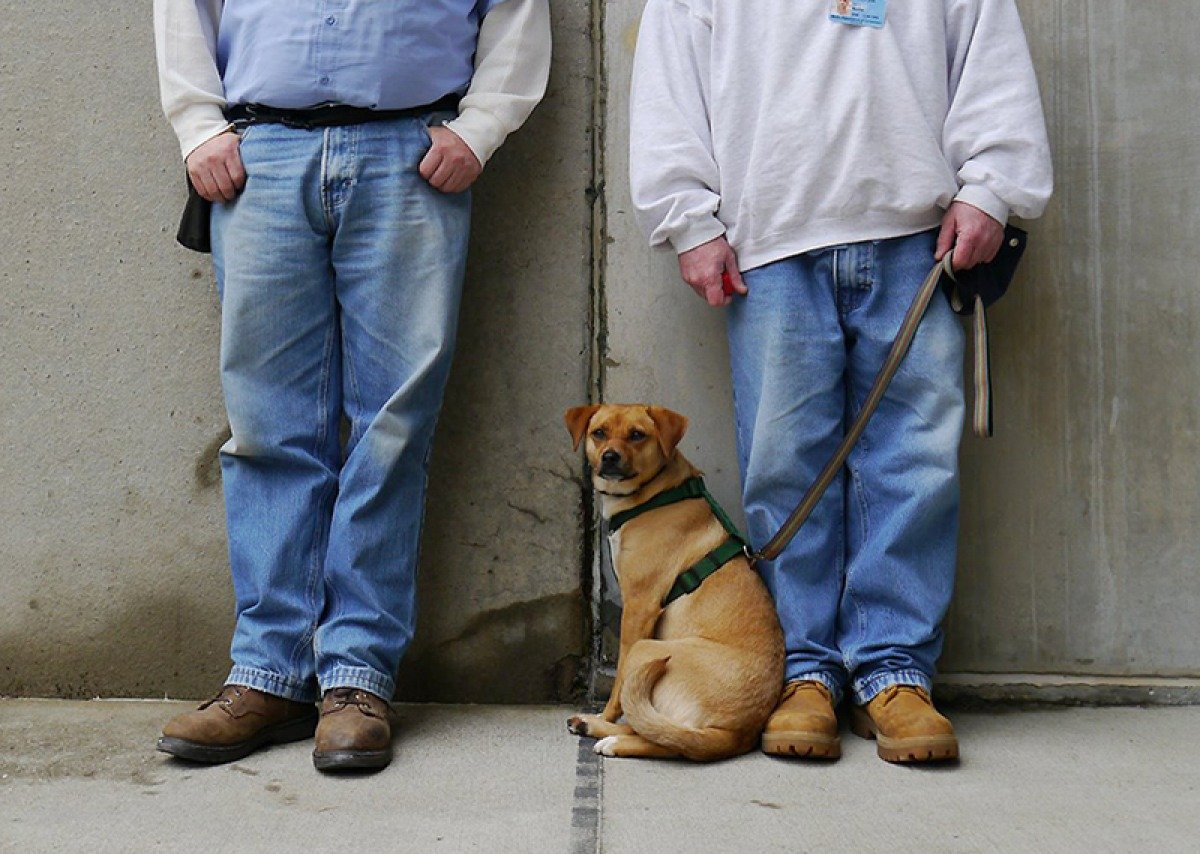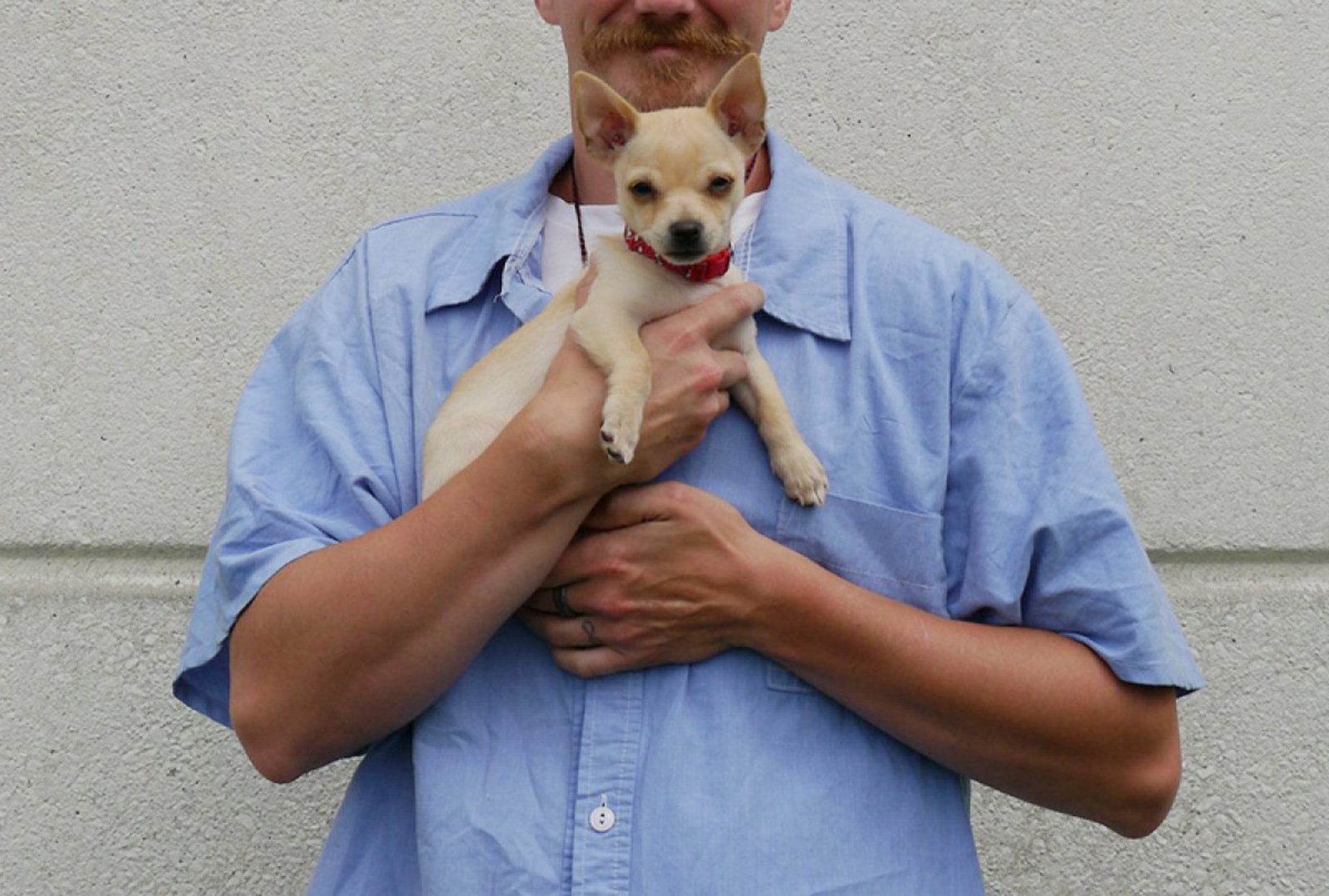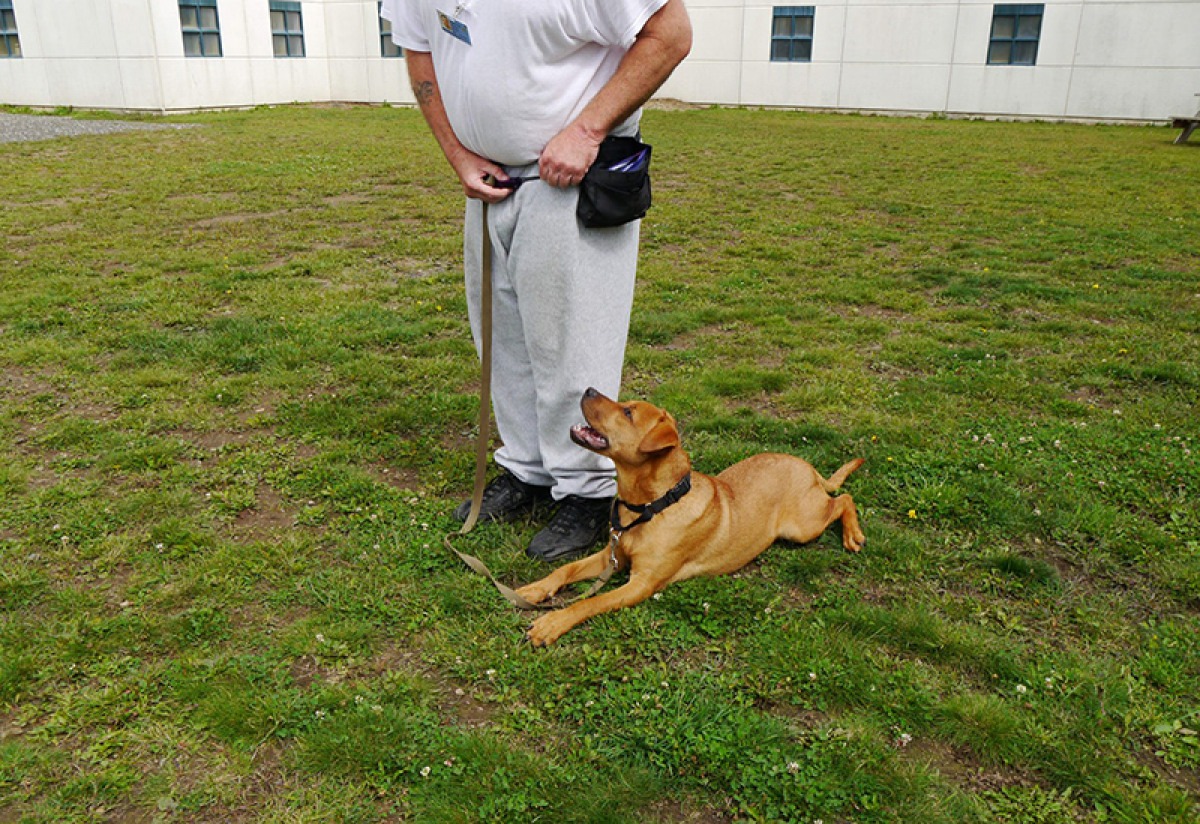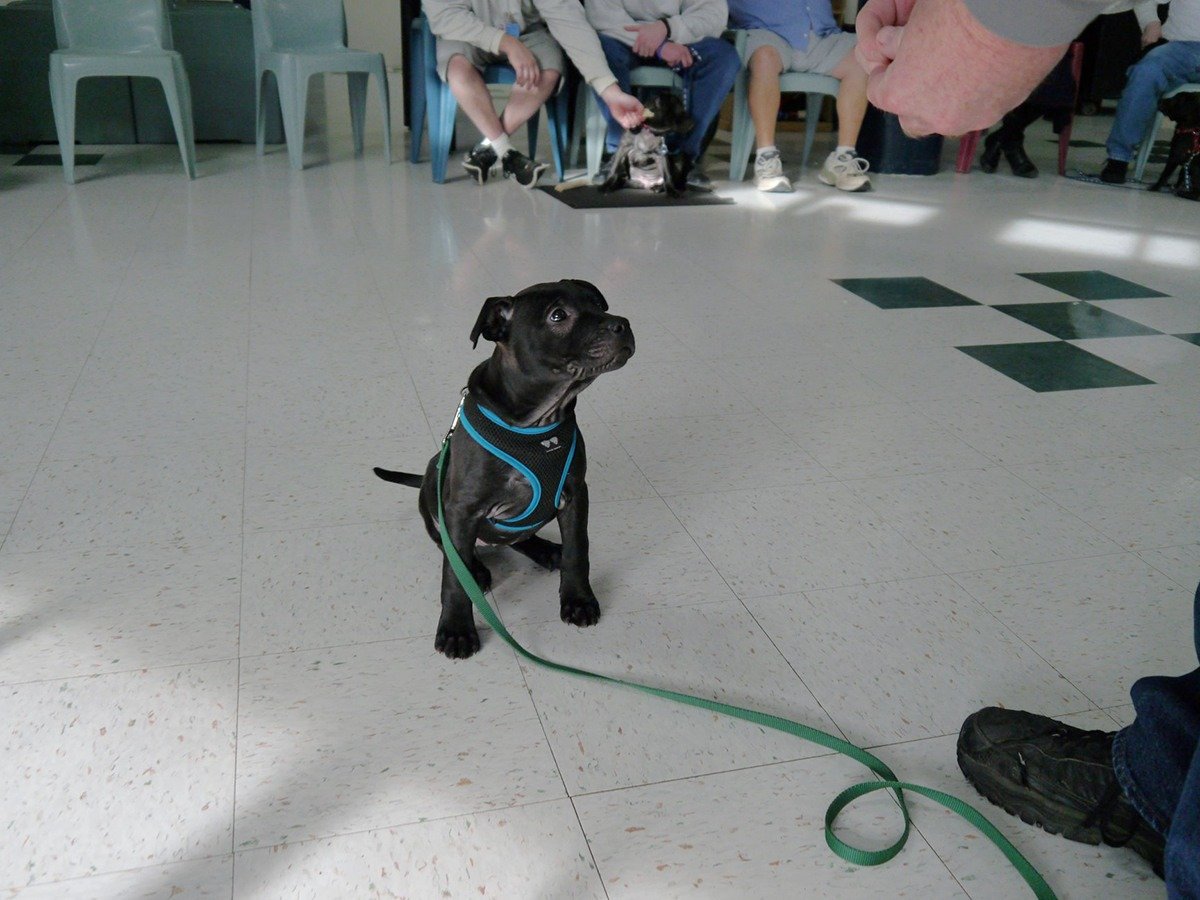Of all the dogs I have trained, none of them challenged or changed me more than Reba. I am currently incarcerated at the Maine State Prison (MSP) and part of a dog-training program called K9 Corrections. We work in partnership with a local shelter that sends us dogs of all ages, from puppies to adults. Our duties not only include basic obedience training, house-training and getting a dog used to a crate for prolonged periods of time, but also, working with dogs like Reba.
Reba was an 18-month-old Red Heeler. When our program manager, Marie Finnegan, walked her into our living area, I was immediately struck by the young dog’s beauty. Her milky-white coat was spotted with swirls and patches of amber, and her eyes revealed an unmistakable intelligence. At the same time, she was frantically in heat and clearly overwhelmed by the shouting voices, slamming doors and everyday commotion of prison life.
When Marie placed Reba on my lap, I tried to soothe her, but she was having none of it. Not wanting to disrupt puppy class, I stood up and walked Reba around the day room, giving her copious amounts of treats, which she eagerly took, to help her associate the day room with a positive experience.

As her primary handler, I kept Reba with me for the first two days. Though unsure of me, she was comfortable enough to lie on the bed with me. While on the bed, I gave her treats and occasionally petted her. For the most part, though, I just let her be.
I have worked with reactive dogs for quite some time. In my journey thus far, I have discovered that the easiest way to gain reactive dogs’ confidence is to isolate them in a quiet space and go about my business without trying to force myself on them. To Reba, I was a stranger, someone who may have reminded her of a time she received a harsh correction, a merciless blow or an unforgiving shout.
Her first two days were the most important. Like the reactive dogs who came before her, Reba studied my every move. Conscious of how quickly I moved or how loudly I spoke, I spent those days making her feel as comfortable as possible.
Toward the end of the second day, while I was watching TV, she suddenly stood up and nudged me and licked my face. A little taken aback, I started to play with her, rolling around on my bed as she playfully pounced on me. About a half-hour passed before she settled down and cozied up under my arm. In a matter of minutes, she was asleep. It was clear that I had won her trust, but I was utterly unprepared for what was to come.
Heelers, by nature, are herders. Like many other herding breeds, they can also be temperamental and territorial. They expertly round up sheep, cattle and even horses by running in and out of the herd, sometimes nipping at the animals’ back legs, or position themselves in front of a herd to redirect it. The downside is, when unable to exercise their herding instinct, Heelers often find ways to get in trouble. If this happens, they have a propensity to become reactive, or worse, aggressive.
Like any other intelligent herder, Heelers need consistent mental stimulation, exercise and/or training to release the pent-up energy that develops when they’re idle too long. People looking for a dog often gravitate toward herding breeds because of their intelligence and protective instinct. What many do not realize, however, is that herders often wind up in shelters and rescues as a result of problems caused by not enough exercise. Owners become increasingly frustrated when they are unable to control their dog’s behavior, especially if this behavior turns into reactivity or aggression. While this is not the case for every dog, for Reba, it was.
Some say that herders are a one-handler type of dog, that they tend to bond to a single person. In the case of Reba, their argument rings true. Within a matter of days, Reba began trying to bite other prisoners and staff. She would sometimes leap up from the floor to go after what she perceived to be a threat.
Sometimes, we are the source of a dog’s reactivity; the more fearful we are of a specific situation, the more fearful our dogs become. In turn, dogs act in accordance with our emotional cues, lashing out at the threats encoded in those cues. The other handlers with whom I worked had a difficult time controlling her; they would nervously walk her down the hallway, anticipating an outburst from her. Dogs feed off the emotions of their people, and Reba could sense these handlers’ trepidation.
When she was with me, she was even worse. If anyone came within a foot of me, she would lunge toward them. Some trainers say that dogs are not protective of their people, but rather, they view those people as a resource to be guarded—a source that provides them food, treats and shelter. But with Reba, it felt different. She genuinely seemed to be protective of me and did not like the days when the other handlers worked with her.

Not wanting her to return to the shelter, I decided to implement a rigorous version of behavioral and adjustment training. I knew it was going to take hard work and dedication to complete this task. Even though Reba could be a menace when she was out and about, she was so sweet in my room. She was fiercely attached to me and genuinely happy to see me every time I entered.
When I left, she would jump onto the crate and watch my every move through the cell window. Purposely moving out of her view, I would look back to see her rubber-necking her head as far as it would go to keep me in sight. It was both cute and comical. No matter how many times I left the room or how quickly I returned, she would jump down from the crate, onto the bed and back onto the crate, knocking over everything in her uncontrolled excitement. Determined as I was to make sure she turned out adoptable, I had to set aside my affection for awhile to become a disciplinarian.
All of my methods are based in positive reinforcement, but other humane methods were called for here: time-outs, denied attention and verbal corrections coupled with counter-conditioning and desensitization to extinguish her aggressive behavior. As much as I wanted to enjoy her simply as a dog, I owed her a life, and was going to make sure she would be able to keep hers when she left the prison.
Reba and I became a team. I wrapped an orange scarf around her neck to let others know she was not approachable. For most of the day, I kept a Gentle Leader on her, and she had to work for every single piece of food she got. I did this to keep her motivated; a hungry dog learns quickly that she has to perform certain behaviors to eat.
I spent almost every day with her, walking her around the prison, treating her when groups of people came by and putting her in time-out when she faltered and tried to attack someone. These time-outs consisted of me directing her to “down” and then turning my back on her. Afterward, I would bring her right back to the trigger, making sure her threshold wasn’t crossed, and flood her with treats to desensitize her to the stimulus.
Sometimes, this could be done from a distance, where she could see what would normally trigger her without being too close. Other times, it was impossible, as movement throughout the prison takes place in tight, crowded quarters. In such scenarios, I had to keep her attention by maintaining her in a strict heel so she couldn’t focus on her surroundings. While she was heeling, I rapidly delivered treats, reinforcing her to maintain a laser-like focus on me. It was a frantic but beautiful dance, and we often found ourselves doing it.
For four months, Reba was my constant companion. I would bring her with me to college classes, and we often went to the infirmary to visit sick and dying men, as well as to the intensive mental health unit to visit patients there. I did all of this even though I knew that the people in these places were not going to be able to interact with her as they would with a “normal” dog. But that was not the objective.
My objective was for her to get used to being around people in different environments, with different degrees of stimulation, without becoming triggered. Not only did achieving this objective require vigilance and patience, I also had to learn how to accept constantly failing and starting over when I fell short. When Reba became reactive, I sometimes did, too. Like her, I occasionally forgot my training, yelling at her or giving her leash corrections, both of which I vehemently oppose.
Reba loved to work, and in a matter of weeks, she knew more than 50 behaviors. She was the first dog to perform some of the more complicated tricks in our program, such as reverse weaving, controlled send-outs, jumping off the back on cue to catch toys, and completing an obstacle course on a send-out strictly on verbal cues. She needed this stimulation; she considered it fun.
During our weekly in-class training sessions, Reba shined. She could be off-leash while running her through her paces because I kept complete control over her. Even the times she deviated a little, tensing up toward someone who came too close, she always came back into the heel position by my side when recalled.
At the end of the day, when I was completely exhausted, Reba made the laborious, oftentimes frustrating training worth it. Each day, we went through the same counter-conditioning routine. Each day was filled with mishaps, time-outs and my frustration. But I loved Reba and wanted her to succeed. When I lay down at night, it was hard not to feel as though my efforts were worth it when Reba loved on me.
She would jump on the bed, position herself between the wall and my pillow and, after placing her muzzle on top of my head, drift off into doggy dreams. I often wondered how such a reactive dog could be so affectionate. When I felt depressed or was just having a bad day, she could sense it. She would spend the day idly with me, lying around without a care in the world, not reacting to anything. On those days, Reba did not even react to my cellmate when he walked in the room. Normally, she barked and growled at him and nipped at his heels as he climbed up on his bunk. Yet, when life had me down, she would just rest her head against mine because she knew I needed her love, patience and care just as much as she needed mine.

When the day came for Reba to graduate, I worried, and those worries triggered my insecurities: Was I a good trainer? Had I done enough to rid her of her reactivity and herding? Will she end up back in the shelter? Will she find her forever home? Reba was one of the smartest dogs to come through our program, and she deserved a good home, and to be loved. I knew I could come up with a thousand reasons why she should stay, all of which would have been false pretenses to keep her with me as long as possible.
By the time she graduated, I think I needed her more than she needed me. We had been a team for four months. I had brought her from a reactive, somewhat aggressive dog to one who could be off-leash around people and was reasonably trustworthy.
I had put love I didn’t know I had within myself into her. In return, Reba showed me forgiveness and an eagerness to start over each time I lost my cool with her. She was more than just a dog to me; she was a friend who revealed aspects of myself I never knew existed. Some of these revelations included my preference to work with aggressive and reactive dogs, as well as the often-forgotten fact that, like dogs, people tend to respond to the vibes and energy others put out.
I have always been high-strung, but became even more aware of just how high-strung I was when I observed the effects it had on Reba’s behavior. I discovered that, in part, some of Reba’s reactivity derived from my own attitudes and feelings about my environment. And as every competent trainer knows, these feelings travel down to the other end of the leash. Some of her behaviors were hardwired into her and I may not have fixed all her issues, but I do know she found a home where she is loved. I do know she was never returned to the shelter.
My success with Reba did not derive from the implementation of a successful, technical and regimented training plan. Rather, my success with Reba came from my ability to learn the ways in which my actions and attitudes affected others. Sure, I may have been able to help Reba interact with her surroundings and other people in positive ways, but she left me with a greater gift: the knowledge of just how much we can change the way we approach a difficult situation by changing our attitudes toward and perceptions of it.
When Marie walked out the door with Reba in championship-style heel position, I cried. I cried because I knew it was not my methods that made Reba heel so perfectly for Marie. Instead, it was the love I gave her, along with the changes that had taken place within myself.
Learn more about one of these programs here.
All images courtesy of Maine State Prison K9 Corrections Program
from The Bark https://ift.tt/3mrqXuS https://ift.tt/3nB9TUp


No comments:
Post a Comment